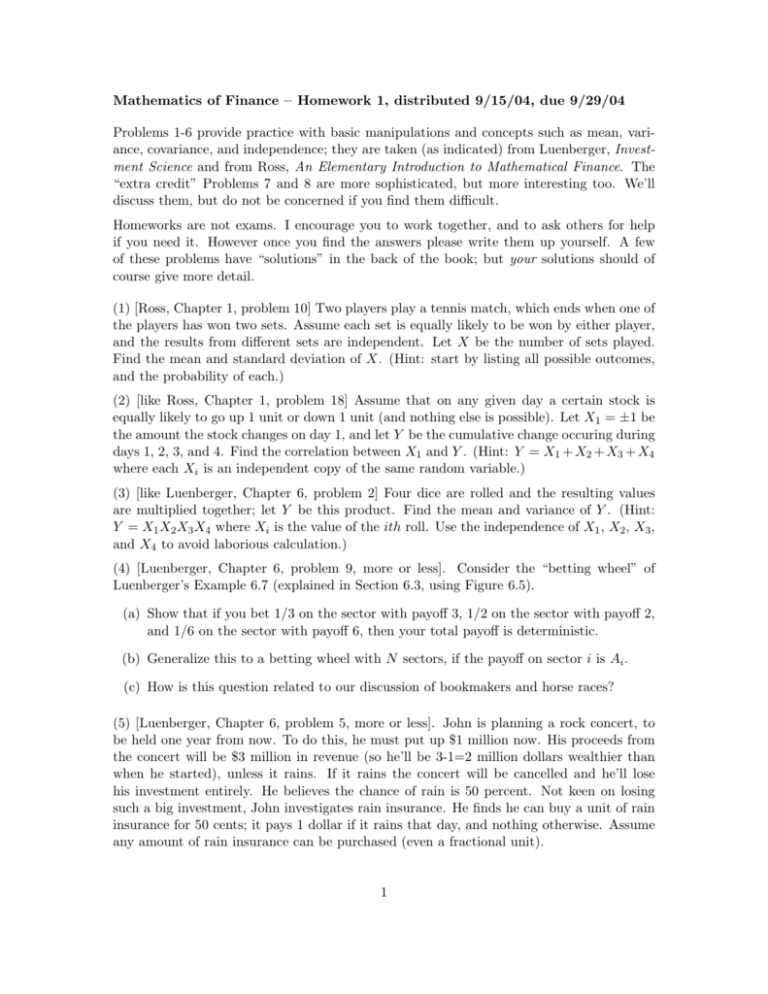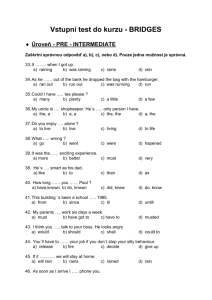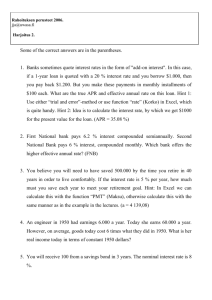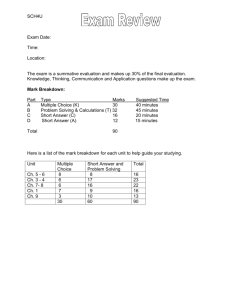Mathematics of Finance – Homework 1, distributed 9/15/04, due 9
advertisement

Mathematics of Finance – Homework 1, distributed 9/15/04, due 9/29/04 Problems 1-6 provide practice with basic manipulations and concepts such as mean, variance, covariance, and independence; they are taken (as indicated) from Luenberger, Investment Science and from Ross, An Elementary Introduction to Mathematical Finance. The “extra credit” Problems 7 and 8 are more sophisticated, but more interesting too. We’ll discuss them, but do not be concerned if you find them difficult. Homeworks are not exams. I encourage you to work together, and to ask others for help if you need it. However once you find the answers please write them up yourself. A few of these problems have “solutions” in the back of the book; but your solutions should of course give more detail. (1) [Ross, Chapter 1, problem 10] Two players play a tennis match, which ends when one of the players has won two sets. Assume each set is equally likely to be won by either player, and the results from different sets are independent. Let X be the number of sets played. Find the mean and standard deviation of X. (Hint: start by listing all possible outcomes, and the probability of each.) (2) [like Ross, Chapter 1, problem 18] Assume that on any given day a certain stock is equally likely to go up 1 unit or down 1 unit (and nothing else is possible). Let X1 = ±1 be the amount the stock changes on day 1, and let Y be the cumulative change occuring during days 1, 2, 3, and 4. Find the correlation between X1 and Y . (Hint: Y = X1 + X2 + X3 + X4 where each Xi is an independent copy of the same random variable.) (3) [like Luenberger, Chapter 6, problem 2] Four dice are rolled and the resulting values are multiplied together; let Y be this product. Find the mean and variance of Y . (Hint: Y = X1 X2 X3 X4 where Xi is the value of the ith roll. Use the independence of X1 , X2 , X3 , and X4 to avoid laborious calculation.) (4) [Luenberger, Chapter 6, problem 9, more or less]. Consider the “betting wheel” of Luenberger’s Example 6.7 (explained in Section 6.3, using Figure 6.5). (a) Show that if you bet 1/3 on the sector with payoff 3, 1/2 on the sector with payoff 2, and 1/6 on the sector with payoff 6, then your total payoff is deterministic. (b) Generalize this to a betting wheel with N sectors, if the payoff on sector i is Ai . (c) How is this question related to our discussion of bookmakers and horse races? (5) [Luenberger, Chapter 6, problem 5, more or less]. John is planning a rock concert, to be held one year from now. To do this, he must put up $1 million now. His proceeds from the concert will be $3 million in revenue (so he’ll be 3-1=2 million dollars wealthier than when he started), unless it rains. If it rains the concert will be cancelled and he’ll lose his investment entirely. He believes the chance of rain is 50 percent. Not keen on losing such a big investment, John investigates rain insurance. He finds he can buy a unit of rain insurance for 50 cents; it pays 1 dollar if it rains that day, and nothing otherwise. Assume any amount of rain insurance can be purchased (even a fractional unit). 1 (a) Can John completely eliminate his risk by buying the right amount of rain insurance? [Hint: think about problem 4.] If so, what is his return on the resulting risk-free investment? (b) Suppose John buys x units of rain insurance. Find the expected rate of return on his investment as a function of x. (c) Check that your answers to (a) and (b) are consistent. [Note: the return is payoff/investment; in this problem the investment is $1 million plus the cost of insurance.] (6)h Recall that the icovariance of two random variables X and Y is defined as σXY = E (X − X)(Y − Y ) . Show that this is equal to E [XY ] − XY . (Hint: review the expla2 nation that Var(X) = E X 2 − X , on page 143 of Luenberger.) (7) Extra credit [Ross, Chapter 1, problem 13; this is very standard.] Let X1 , . . . , XN be independent copies of a single random variable, with expected value µ and variance σ 2 . The sample mean M is defined by X1 + · · · + XN M= N (this is the estimated mean based on N independent experiments). Show that (a) E[M ] = µ (b) Var(M ) = σ 2 /N . The sample variance V is defined by PN V = − M )2 N −1 i=1 (Xi (this is the estimated variance based on N independent experiments; the denominator is N − 1 not N due to part (d) below). (c) Show that PN i=1 (Xi − M )2 = PN 2 i=1 Xi − N M 2. (d) Conclude that E[V ] = σ 2 . (8) Extra credit. Schwartz’s inquality says that if (v, w) is an inner product on RN then p p |(v, w)| ≤ (v, v) (w, w). Use this to show that |σXY | ≤ σX σY . (Hint: suppose the possible values of the pair (X, Y ) are (Xγ , Yγ ), 1 ≤ γ ≤ N , and (Xγ , Yγ ) occurs with P probability ργ . Use the inner product (v, w) = N γ=1 vγ wγ pγ . What is the good choice of v and w?) 2






